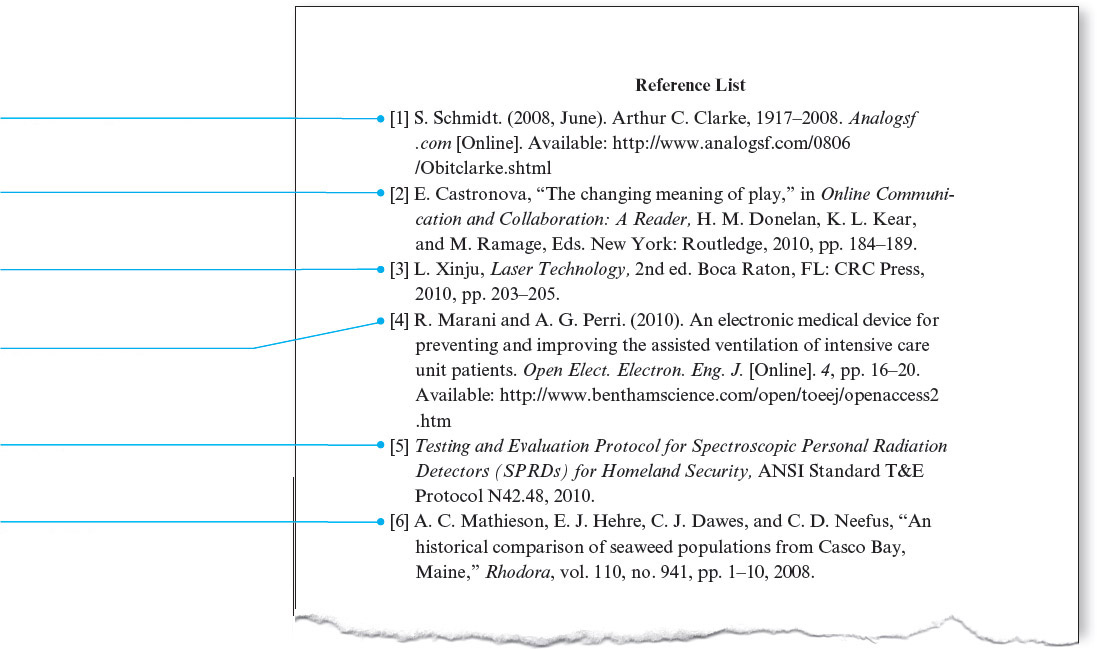IEEE Style
Printed Page 633-640
IEEE Style
IEEE style consists of two elements: citations in the text and a reference list at the end of the document.
| IEEE Style for Reference List Entries | |||
| BOOKS | ELECTRONIC SOURCES | ||
| 1. Book by One Author | 10. Article in an Online Journal or Magazine | ||
| 2. Book by Multiple Authors | 11. Website | ||
| 3. Book Authored by an Organization | 12. Document on a Government Website | ||
| 4. Edited Book | OTHER SOURCES | ||
| 5. Chapter or Section in an Edited Book | 13. Thesis or Dissertation | ||
| 6. Book in an Edition Other Than the First | 14. Standard | ||
| PRINT PERIODICALS | 15. Scientific or Technical Report | ||
| 7. Journal Article | 16. Paper Published in Conference Proceedings | ||
| 8. Magazine Article | 17. Government Document | ||
| 9. Newspaper Article | 18. Unpublished Document | ||
In the IEEE (originally, Institute of Electrical and Electronics Engineers) documentation system, citations in the text are bracketed numbers, keyed to a numbered list of references that appears at the end of the document. Entries in the list are arranged in the order in which they are cited in the text and are numbered sequentially. Once a reference has been listed, the same number is used in all subsequent citations of that source.
To cite references in the text, place the reference number or numbers immediately after the author’s name, in square brackets, before any punctuation. Use et al. if there are three or more author names.
A recent study by Goldfinkel [5] shows that this is not an efficient solution. Murphy [8]–[10] comes to a different conclusion.
You can also use the bracketed citation number or numbers as a noun.
In addition, [5] shows that this is not an efficient solution; however, [8]–[10] come to a different conclusion.
NOTE: Because references are listed in the order in which they first appear in the text, if you add a new citation within the text while rewriting or editing, you will need to renumber the reference list as well as the citations in the text. For example, if in rewriting you were to add a new reference between the first citations of the Murphy references originally numbered [8] and [9], the previous example would then read:
[8], [10], [11] come to a different conclusion.
To make a reference more precise, you can provide extra information.
A recent study by Goldfinkel [5, pp. 12–19] shows that this is not an efficient solution.
The following guidelines will help you prepare IEEE-style references. For additional information on formatting entries, consult the latest edition of The Chicago Manual of Style.
- Arranging entries. Arrange the entries in the order in which they first are cited in the text, and then number them sequentially. Place the numbers in square brackets and set them flush left in a column of their own, separate from the body of the references. Place the entries in their own column, with no indents for turnovers.
- Authors. List the author’s first initial (or first and middle initials, separated by spaces), followed by the last name. In the case of multiple authors, use all names; use et al. after the first author’s name only if the other names are not given. If an entry has an editor or translator in place of an author, add the abbreviation Ed. (or Eds. for editors) or Trans. following the name.
- Book titles. Italicize titles of books. In English, capitalize the first word and all major words. In foreign languages, capitalize the first word of the title and subtitle, as well as any words that would be capitalized in that language.
- Publication information. For books, give the city of publication, the country (if other than the United States), the publisher’s name (abbreviated), and the year of publication. When two or more cities are given on a book’s copyright page, include only the first. If the city is not well known, add the abbreviation for the name of the state or province (in Canada). If the publisher’s name indicates the state, no state abbreviation is necessary.
- Periodical titles. Italicize and abbreviate titles of periodicals. Capitalize all major words in the title.
- Article titles. Place titles of print articles in quotation marks; do not use quotation marks for titles of articles found in electronic sources. Capitalize the first word of the title and subtitle. Do not capitalize the remaining words unless they are proper nouns.
- Electronic sources. Follow the special style for electronic sources in which, most notably, the sequence of information is different from that for print material (the date follows the author, and the year comes before the month). Do not place article titles in quotation marks, and use periods rather than commas to separate sections. In addition to the basic information, give the medium and provide a way to locate the source by including, for example, a URL.
- Spacing. Single-space the reference list, and do not add extra space between entries.
- Page numbers. To give a page or a range of pages for a specific article in a book or periodical, use the abbreviation p. or pp. Write numbers in full (152–159, not 152–59 or 152–9).
- Dates. For print sources, follow the format month (abbreviated), day, year (for example, Apr. 3, 2010 or Feb. 22–23, 2011). Do not abbreviate May, June, or July. For electronic sources, follow the format year, month (abbreviated), day (for example, 2011, Oct. 14).
BOOKS
1. Book by One Author Include the author’s first initial and middle initial (if available), the author’s last name, the book title (in italics), the place of publication, the publisher, the year of publication, and the page range of the material referenced.
[1] B. Mehlenbacher, Instruction and Technology: Designs for Everyday Learning. Cambridge, MA: MIT Press, 2010, pp. 22–28.
2. Book by Multiple Authors List all the authors’ names. Use et al. after the first author’s name only if the other names are not given. Do not invert names, and include a comma before and only if there are three or more names.
[2] S.-T. Yau and S. J. Nadis, The Shape of Inner Space: String Theory and the Geometry of the Universe’s Hidden Dimensions. New York: Basic Books, 2010, pp. 254–255.
3. Book Authored by an Organization The organization takes the place of the author.
[3] World Bank, World Development Report 2011: Conflict, Security, and Development. Washington, DC: World Bank, 2011, pp. 25–31.
4. Edited Book Include the abbreviation Ed. (singular) or Eds. (plural) after the name(s).
[4] J. Dibbell, Ed., The Best Technology Writing 2010. New Haven: Yale University Press, 2010, pp. 157–162.
5. Chapter or Section in an Edited Book Give the author and the title of the chapter or section first (enclosed in quotation marks and with only the first word capitalized), followed by the word in, the book title, and the book editor(s). Then give the publication information for the book and the page numbers where the chapter or section appears.
[5] E. Castronova, “The changing meaning of play,” in Online Communication and Collaboration: A Reader, H. M. Donelan, K. L. Kear, and M. Ramage, Eds. New York: Routledge, 2010, pp. 184–189.
6. Book in an Edition Other Than the First The edition number follows the title of the book and is preceded by a comma.
[6] L. Xinju, Laser Technology, 2nd ed. Boca Raton, FL: CRC Press, 2010, pp. 203–205.
IEEE: CITING A BOOK BY ONE AUTHOR
When citing a book, use the information from the title page and the copyright page (on the reverse side of the title page), not from the book’s cover or a library catalog.
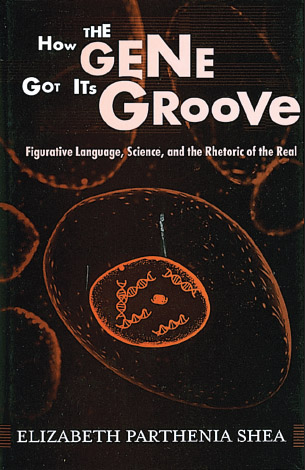
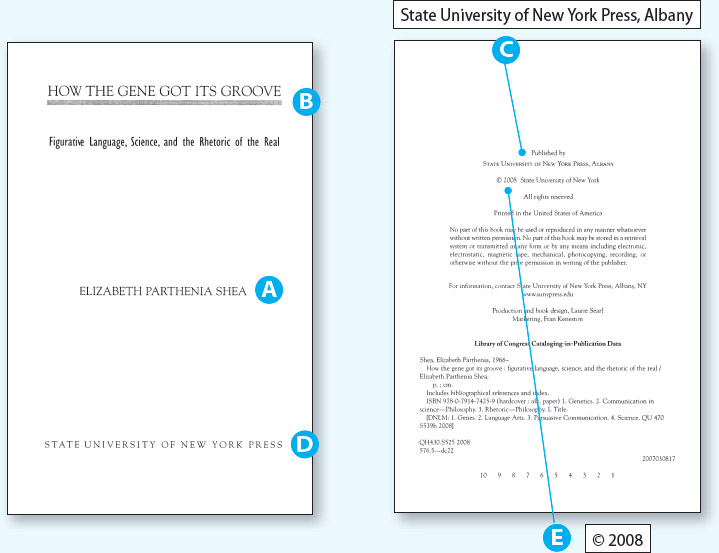
From How the Gene Got Its Groove: Figurative Language, Science, and the Rhetoric of the Real, edited by Elizabeth Parthenia Shea.
Copyright © 2008 The State University of New York Press. Reprinted by permission. All rights reserved.
Record the following information:
A The author. Give the initials for the first and middle names, followed by the last name. Separate initials with a space. End with a comma.
B The title. Give the full title in italics; include the subtitle (if any), preceded by a colon. Capitalize the first word of the title, the first word of the subtitle, and all major words. End with a period.
C The place of publication. If more than one city is given, use the first one listed. For a city that may be unfamiliar to your readers or confused with another city, add an abbreviation of the state or province (in Canada): Sweetwater, TX. Give the country if not the United States: Milan, Italy. Insert a colon.
D The publisher. Use a concise version of the publisher’s name. End with a comma.
E The date of publication. Use the publication date, if given. Otherwise, use the copyright date. End with a comma.
F The pages referenced. Give the page range of the material referenced, preceded by p. or pp.

PRINT PERIODICALS
7. Journal Article Include the author, the article title, and the journal title (abbreviated where possible), followed by the volume number, issue number, page number(s), abbreviated month, and year (or abbreviated month, day, and year for weekly periodicals).
[7] R. C. Weber, P.-Y. Lin, E. J. Garnero, Q. Williams, and P. Lognonne, “Seismic detection of the lunar core,” Science, vol. 331, no. 6015, pp. 309–312, Jan. 21, 2011.
8. Magazine Article List the author, the article title, and the magazine title (abbreviated where possible), followed by the page number(s) and the issue date.
[8] J. Villasenor, “The hacker in your hardware,” Scientific Amer., pp. 82–87, Aug. 2010.
9. Newspaper Article List the author, the article title, and the newspaper name, followed by the section and the date.
[9] M. Woolhouse, “For many, snow day is business as usual,” Boston Globe, sec. B, Jan. 13, 2011.
ELECTRONIC SOURCES
10. Article in an Online Journal or Magazine
[10] R. Marani and A. G. Perri. (2010). An electronic medical device for preventing and improving the assisted ventilation of intensive care unit patients. Open Elect. Electron. Eng. J. [Online]. 4, pp. 16–20. Available: http://benthamopen.com/ABSTRACT/TOEEJ-4-16
11. Website
[11] American Institute of Physics. (2011). American Institute of Physics [Online]. Available: http://www.aip.org
12. Document on a Government Website
[12] U.S. Department of Health and Human Services, Centers for Disease Control and Prevention. Preparation and planning for bioterrorism emergencies [Online]. Available: http://emergency.cdc.gov/bioterrorism/prep.asp
OTHER SOURCES
13. Thesis or Dissertation
[13] J. L. Beutler, “Frequency response and gain enhancement of solid-state impact-ionization multipliers (SIMs),” Ph.D. dissertation, Dept. Elect. Eng., Brigham Young Univ., Provo, UT, 2010.
14. Standard For standards, include the title in italics, the standard number, and the date.
[14] Testing and Evaluation Protocol for Spectroscopic Personal Radiation Detectors (SPRDs) for Homeland Security, ANSI Standard T&E Protocol N42.48, 2010.
15. Scientific or Technical Report
[15] E. G. Fernando, “Investigation of rainfall and regional factors for maintenance cost allocation,” Texas Transportation Inst. Texas A&M, College Station, TX, Report 5-4519-01-1, Aug. 2010.
IEEE: CITING AN ARTICLE FROM A PRINT PERIODICAL
Periodicals include journals, magazines, and newspapers. This page gives an example of a citation for an article from a print journal.
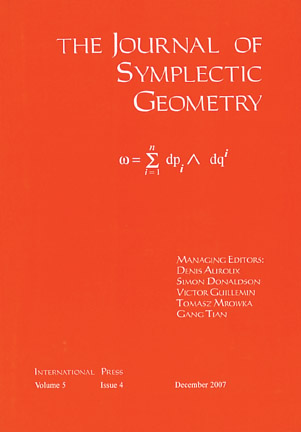
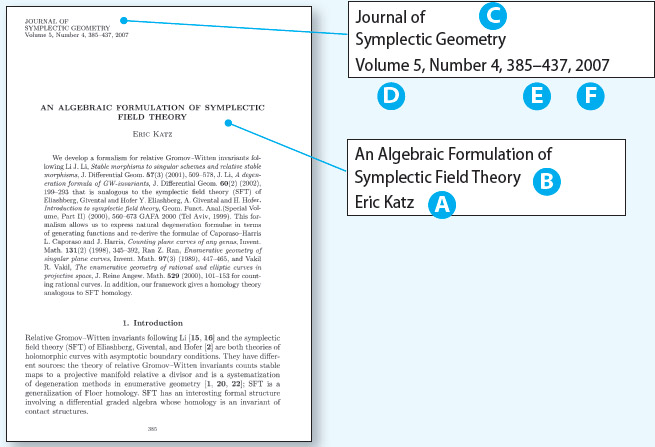
From The Journal of Symplectic Geometry, Volume 5, Issue 4, December 2007. Reprinted by permission of International Press of Boston.
Record the following information:
A The author. Give the initials for the first and middle names, followed by the last name. Separate initials with a space. End with a comma.
B The article title. Give the full title; include the subtitle (if any), preceded by a colon. Capitalize only the first word of the title, the first word of the subtitle, and proper nouns. End with a comma. Enclose all in quotation marks.
C The periodical title. Give the abbreviated title, in italics, with each word capitalized. End with a comma.
D The volume number and issue number. Include the volume and issue numbers, using the abbreviations vol. and no. Follow each number with a comma.
E Inclusive page numbers. Give the page range for the article. End with a comma.
F The date of publication. Give the abbreviated month, followed by the year or the day and year. End with a period.

IEEE: CITING AN ARTICLE FROM AN ONLINE DATABASE
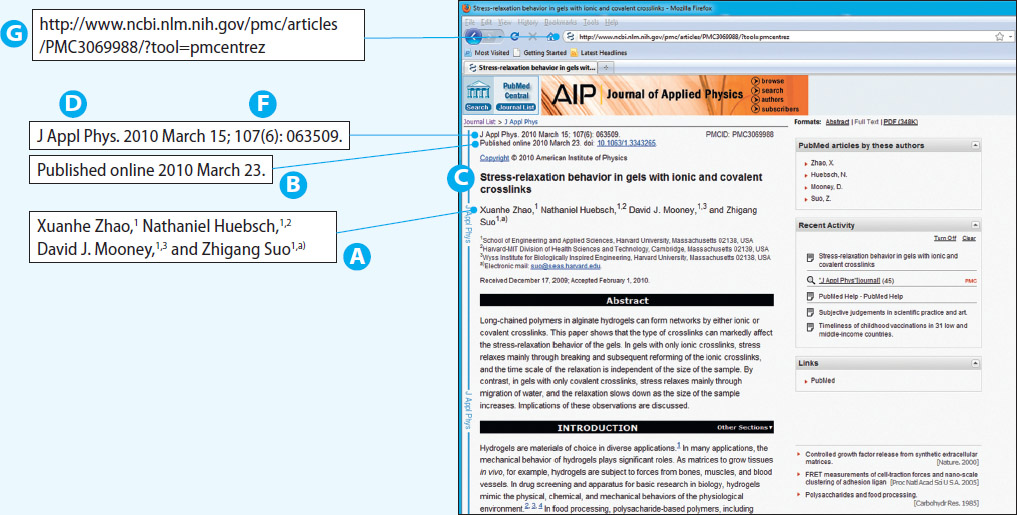
Record the following information:
A The author. Give the initials for the first and middle names, followed by the last name. Separate initials with a space. End with a period.
B The date of the article’s online publication. In parentheses, put the year, followed by a comma, then the abbreviated month, and the day (if available). End with a period.
C The article title. Include the title, followed by a period (unless the title ends with its own punctuation). Capitalize only the first word of the title, the first word of the subtitle, and proper nouns. Do not enclose the article title in quotation marks or italicize it.
D The periodical title. Give the abbreviated journal title in italics. Do not end with a period if the last word is spelled out in full.
E Medium. Place the medium in square brackets and end with a period: [Online].
F The volume number, issue number, and pages. Put the issue number in parentheses immediately after the volume number, and italicize the volume number and issue number. Give the page numbers where the article appears, if known, preceded by a comma. End with a period.
G Retrieval information. After the word Available: and a space, include the URL for the database or the article. Do not end with punctuation unless the URL does.

16. Paper Published in Conference Proceedings
[16] T. O’Brien, A. Ritz, B. J. Raphael, and D. H. Laidlaw, “Gremlin: An interactive visualization model for analyzing genomic rearrangements,” in Proc. IEEE Information Visualization Conf., 2010, vol. 16, no. 6, pp. 918–926.
17. Government Document
[17] W. R. Selbig and R. T. Bannerman, “Characterizing the size distribution of particles in urban stormwater by use of fixed-point sample-collection methods,” U.S. Geological Survey, Open-File Report 2011-1052, 2011.
18. Unpublished Document
[18] S. Reed, “An approach to evaluating the autistic spectrum in uncooperative adolescents,” unpublished.
Following is a sample reference list using the IEEE numbered reference system. The references are listed in the order in which they might appear in a fictional document.
Article in an online magazine
Chapter in an edited book
Book in an edition other than the first
Online journal article
Standard
Journal article
